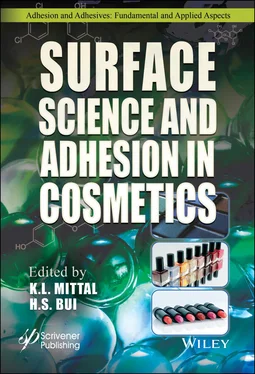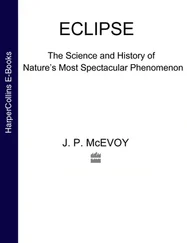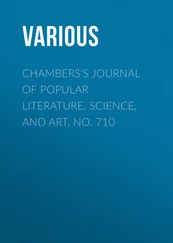1.3.2.2.3 Adhesion with Scotch ®Tape
To determine the adhesion property of the formulation, the wear assay can also be completed with a Scotch tape, in which the tape is placed on top of the sample and removed at a 90° angle. A similar visual assessment is made to analyze the quality of the sample. These visual inspections are then translated to a ranked scale. Figure 1.6(right) shows what is considered to be a good and a bad sample after the test is completed. The long-wear lipstick formula would ideally have a higher adhesion to the substrate rather than to the tape, preventing any formulation from being removed.
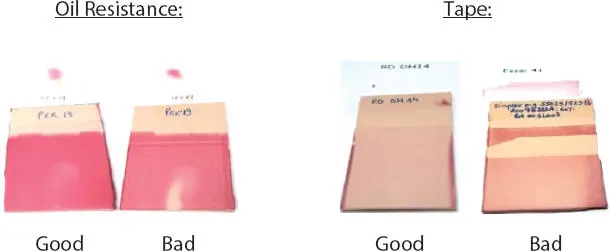
Figure 1.6 Wear assay results indicating satisfactory (left) and unsatisfactory (right) resistance to oil and formulation adhesion (tape test).
1.3.2.2.4 Adhesion Testing
Adhesion testing measures the adherence quality to a specific substrate after formulation application. This indicates how well a formulation will remain on a consumer’s lips over a period of time. The formulation is applied onto the BIOSKIN surface and left to dry. ASTM crosshatch tape is applied onto the film surface and removed at a 180° angle [54]. The amount of film removed with the tape is rated on a scale from 1-3, where 1 indicates no removal, 2 is some removal, and 3 is severe removal [54]. This scale relates back to how formulations are rated in consumer sensory testing. There are other means to measure the film adhesion; rather than using the ASTM crosshatch tape, two pieces of BIOSKIN can be used in contact with the formulation located in between. One piece of BIOSKIN can be peeled off either manually and the adhesion is evaluated by the ratings described above. Alternatively, a texture analyzer can be used to peel apart the BIOSKIN in order to quantify the force needed for removal.
1.3.2.3 Lipstick Cohesion Test
This method utilizes lipstick formulation drawn down on the BIOSKIN substrate using a 25µm or 75µm drawdown bar. The sample dries for about one to two hours at 37°C and 35%RH. Once dry, the BIOSKIN substrate is stretched twice manually in both the X and Y directions. A visual assessment of the sample for cracking is made.
Figure 1.7demonstrates what would classify as performing well with the stretch test (left), as compared to that which performed poorly (right). This test is used to mimic consumer experience through the movement of their lips to determine if the deposited film would result in cracks and other undesirable visual effects. Such movements may include talking, yawning, and smiling which could result in the lipstick wearing off. Cracking is rated on a scale from 1 to 5 depending on the severity of crack formations that were observed.

Figure 1.7 Lipstick stretch test results indicating no cracking (left) and severe cracking (right) after manual stretching.
Tack is used to identify the quality of the formulation after application to a substrate and relates to what the consumer may feel in regards to stickiness either after application or after eating oily foods that may cause the formulation to degrade, in turn causing the formulation to run off or have a tacky feel. This method uses the Texture Analyzer and calculates the removal force of a 1/2” stainless steel ball probe after contact with the dried formulation [54]. The maximum force detected is considered to be the tack. This measurement is conducted five times on a sample and averaged in order to find the average tack force for the sample. This test can also be conducted after exposure to olive oil and saliva to determine the impact on the formulation, relating to product performance after eating or after the consumer licks her lips. Long-wear lipsticks that have a wide stick have a higher tack force as a result of higher evaporation of the volatile solvent.
1.3.2.5 Thermal Analysis of Lipsticks
Differential Scanning Calorimetry (DSC) measures the melting of the fats and oils in the sample to provide an idea of product performance [61]. This technique, referred to as fingerprinting, provides information regarding product wear and performance as a direct relation to peak shape, size, and temperature after being run on a single furnace, heat flux DSC [61]. We can look at the signature peaks from the DSC readout to help characterize the type of wax and expected consumer sensory. This method is ideal for long-wear sticks as the isododecane helps keep the stick soft and acts as a solvent for the different waxes in the formulation. Typically, liquid format long-wear lipsticks are not preferred for this method as there is a very small amount of wax in the formulation, making it hard to fingerprint.
A sample profile can be seen in Figure 1.8. In this experiment, 30mg of samples for lipstick formulations A, B, C, and D were placed in hermetically sealed aluminum pans and were ramped from -100°C to 100°C at a rate of 2°C/minute to obtain the full DSC profile of the sample [61]. The figure demonstrates that there are melting peaks between 25°C to 50°C, indicating that the samples will spread on warm surfaces, such as the lips [61]. The location of the peaks can help to identify the type of wax used in the formulation; for example, in Formulation D in Figure 1.8, we can conclude that different waxes that have a higher melting temperature and must be harder compared to Formulations A-C due to the location and intensity of the peaks. Peaks located at higher temperature indicate that the formulation may be more difficult to apply to the lip due to its lower temperature, but once applied will stay longer [61].
This provides further insight into the application process experienced by consumers. Softer formulations will melt on the lip during application but will still be hard enough to resist snapping when used; this provides a positive sensory experience for the consumer.
1.3.3 Visual Properties of Lipstick Formulations
1.3.3.1 Transfer Resistance Test
The transfer resistance test, also known as the “kiss” test, is a commonly used evaluation method in order to determine the transfer of product from the lip after lipstick application. This provides an indication as to what may be experienced by consumers in terms of transferring color to undesired places such as glassware, clothing, silverware, or other lips [3]. Not only does this issue result in color appearing in unwanted locations, but it also ruins the appearance of the consumer’s lips, resulting in an uneven coating of the lipstick. This method is an effective way to rank the transfer-resistant ability of long-wear lipsticks.
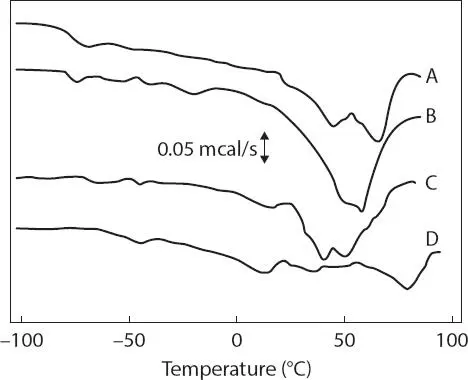
Figure 1.8 DSC profiles of lipstick formulation samples A-D [61].
The formulation is applied to a keratinous material, such as the human lips, and left to dry for about fifteen minutes. After this time, another substrate such as skin, artificial skin, lips, or glass is kissed. The amount of formulation transferred to the substrate is reviewed and ranked on a scale from little or no transfer to complete transfer. Should the formulation be transfer-resistant, then a majority will remain on the lips [4].
Читать дальше
